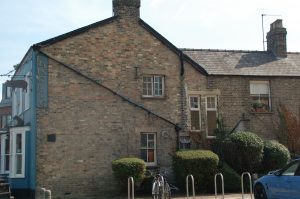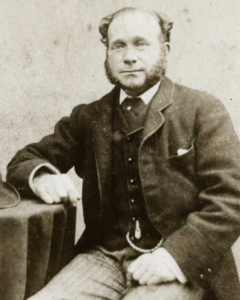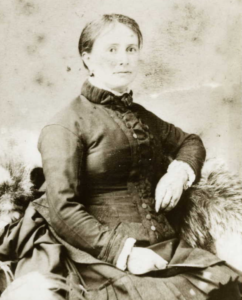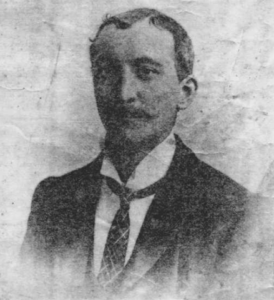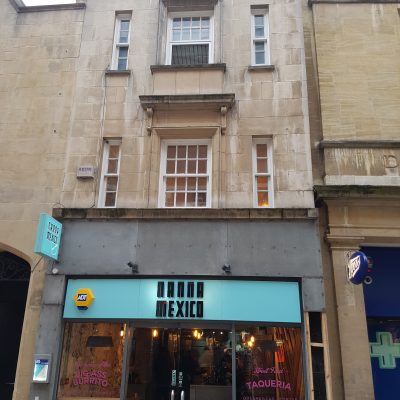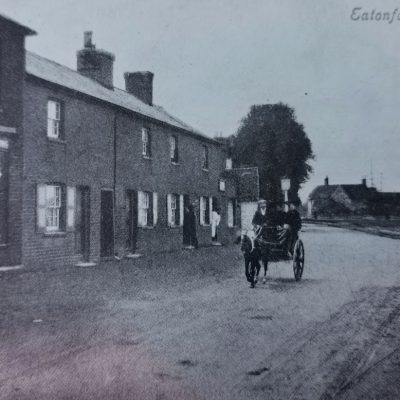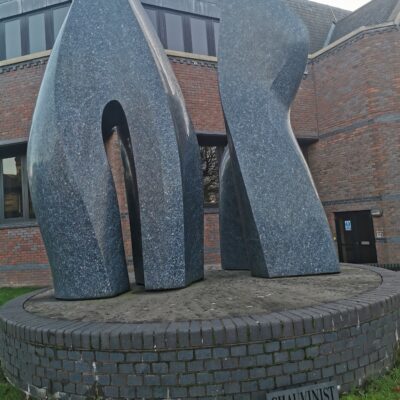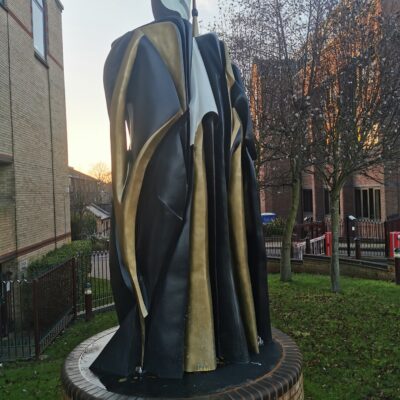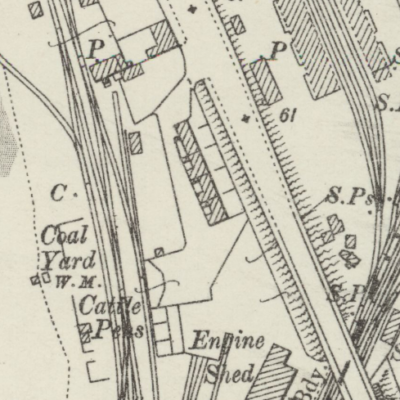Search by topic
- archaeology
- Building of Local Interest
- chapel
- charity
- church
- crime
- dressmaker
- fire
- Great Eastern Railway
- Listed building
- Mapping Relief
- medieval
- oral history
- poverty
- Public House
- Religious House
- Roman
- scholar
- school
- Then and Now
- tudor
- women
- work
- world war one
- world war two
Search by text
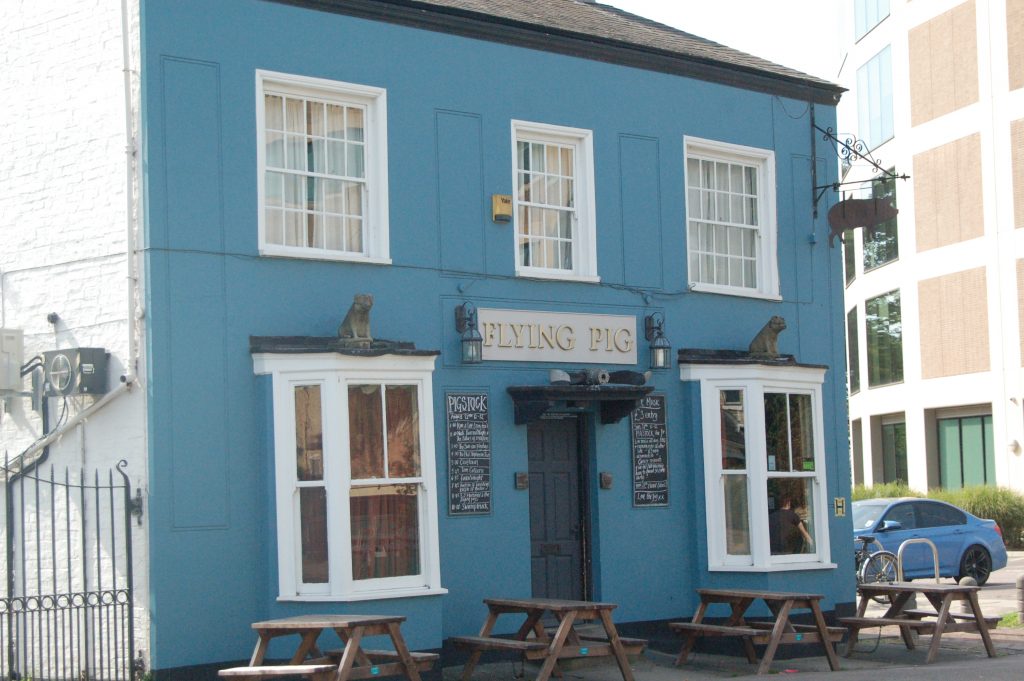 Hills Road Flying Pig
Hills Road Flying Pig106 Hills Road, The Crown Inn, The Flying Pig, (41 The Engineer)
History 106 Hills Road
‘A Disorderly House‘ (Nick Barraclough 2018) is a wonderful source of information about this pub and the surrounding area. He traces the origin of the pub to the choice of the field boundary which became the new Station Road. A map from 1844 is the first record of the existence of the pub which was first called the Engineer, next to the Osborne Arms. Nearby there was also a maltings and another pub, the Railway Vue.
1845
Charles Hinds was granted a licence at the Engineer on 17th June 1845. (Possibly the same man as Charles Hinds stableman at the Blackmoor’s Head (Mitre) in Bridge Street according to Barraclough).
George Traise was granted his licence at the Engineer on 31st July 1845. He was working in 1844 as head ostler at the King’s Head in Sidney Street. He came with his wife Mary and a baby, Lucy, followed. George died on 4th October 1850; he was described as a groom, rather than publican, and his widow took over the licence.
1851
Mary Traise, widow, 34, innkeeper, b Dover
Lucy, 5, b Cambridge
Betsey, sister, 20, b Norfolk
Jane Peachey, 19, house servant, b Fulbourn
Daniel Pammerty, 18, H ostler, b Linton
By 1851 the census return suggests that the Engineer was also an inn providing bed and board. As well as the family there were servants including an ostler. Mary Traise gave up the licence in Michaelmas 1854; she married a James Berridge in London but they returned to Cambridge.
1854
Elizabeth Anderson took over the licence 1 December 1854. She seems to have been previously ‘beer retailer’ in Sussex Street. The Engineer was one of the pubs belonging to the Plough Brewery.
There are two stories in the press about the pub at their time:
9/12/1854 Cambridge Chronicle: Stealing Game
3/11/1855 Cambridge Independent press: Drunk and Disorderly
The Plough Brewery’s owner, William Herring Smith died in 1857 and the brewery closed. Elizabeth Anderson had ceased to be at The Engineer by then and the licence was taken on by William Wilkes Featherstonehaugh of the newly found Crown Brewery on Newmarket Road
William H Smith is listed in the 1851 census as being 45 yrs old, Treasurer of the Borough, Brewer and Farmer of 33 acres. He lived with his family in Smith’s Yard, Magdalen Street.
1857
In this year a story in the press names Miss A Benson as the occupier of The Engineer.
31/1/1857 Cambridge Independent Press: Dratton v Benson
Miss Benson had previously lived in Cambridge Place but seems to have moved with Mr Drayton to The Engineer.
24/1/1857 Cambridge Independent Press: Disorderly House
24/1/1857 Cambridge Chronicle and Journal
William Featherstonehaugh had problems renewing his licence of The Engineer because of the management under the Miss Bensons:
29/8/1857 Cambridgeshire Independent Press
Featherstonehaugh did manage to find a replacement for the Miss Benson, a Jesse Nicholls,
3/10/1857 Cambridge Chronicle
But it seems that the Miss Bensons remained in the picture and there were further complaints.
28/8/1858 Cambridge Independent Press
Finally the freeholder Thomas Ashby, on behalf of George Grimes, was granted the licence. He had been living next door at 35 Hills Road according to the 1851 census. He wasn’t a publican but employed Grimes to run the pub.
1858
In this year George Grimes married Ann Benson – 10 October 1858 at St Paul’s. Their daughter Catherine Mary, was born October 1859.
George Grimes was born 1830 in Herts. and was probably the same George Grimes prosecute for larceny in 1848.
Ann Benson was born Waterbeach 1828. In 1851 she was a dress maker living at 6 [not 28] Eden Street with her father Nathan, a miller, and younger sister Mary, a shawl and bonnet maker. Barraclough speculates that the father made have died soon after this putting the daughters into penury and forcing them to take residence in Cambridge Place. This is very probable. It seems from census and death records that that the mother Ann (nee Wedd) died in 1853. The father Nathan died in Cambridge in 1854. There were in fact six daughters according to the 1841 census; the four who were younger than Ann and Mary were by 1851 all household servants either in Cambridge or nearby, even the youngest who was only 11.
The newspapers continue the story when Ashby, owner of the Engineer applied for the licence to be transferred from Grimes to himself:
27/8/1859 Cambridge Chronicle
Thomas Ashby is at this point lodging at 27 [not 17] Union Road. He appears to have suffered a downturn in his fortunes and is now a lodger in a poor area of the city.
Grimes was then reported in the newspaper to have been involved in a serious crash on Hill’s Road.
24/9/1859 Cambridge Chronicle
At first Grimes was considered to be in the wrong. It then came to light that the other cart was on the wrong side of the road.
1/10/1859 Cambridge Chronicle
A few months later, no longer in charge of the Engineer, he was charged in 1860 with being drunk and disorderly:
21/1/1860 Cambridge Chronicle
Despite all this he is described as a respectable looking young man.
21/1/1860 Cambridge Independent Press
Postscript: Catherine Mary Grimes can be found living with her aunt Esther (nee Benson) and her husband William Wallace, in Bruntingthorpe Leics. in 1891. She is described as 30 years old and born in Hills Road Cambridge.
1861
Simon Godfrey, 49, inn keeper and boatbuilder, b Thetford Norfolk
Elizabeth, 43, b Chesterton
Victoria L, 18, b Chesterton
Roland, 14, b Norfolk
According to A Disorderly House, Godfrey had worked as a boat builder in Chesterton in the late 1820s for John Cross. He married John’s daughter Elizabeth and they had three children in Thetford, the youngest, Ebenezer, born blind. Godfrey ran a pub for a brief spell in Kings Lynn at the end of the 1840s. When he returned to Cambridge in 1851 he was an insolvent debtor. Several years of problems with the law involving the family followed while they lived in Chesterton.
In November 1860 the couple are reported too to have taken on the Crown (late ‘Engineer’) Inn.
24/11/1860 Cambridge Independent Press
Crown (late ‘Engineer”) Inn. 41 Hills Road Cambridge
S Godfrey begs leave to inform the Public generally, that he has lately taken the above Inn, and hope by strict attention and assiduity, to obtain a share of their support. Well-Aired Beds. There is excellent Stabling on the premises. S G also begs to state he has opened a Coal Depot. where the best coals may be obtained on the most remarkable terms, for cash.
Simon Godfrey however disappears from the record in 1861. A report in the local press suggests that he may have committed suicide in Essex in 1866.
15/12/1866 Cambridge Independent Press
1862
According to Barraclough (2018) we know little about the next landlord, Joseph Cole. An article in the press mentions him as the owner of the Crown in Hills Road when reporting the theft of a horse’s had stall from the pub.
3/5/1862 Cambridge Independent Press
He could be the same Joseph Cole imprisoned for grievous bodily harm in 1864 (Criminal Register 19/10/1864).
The pub was looking for a new tenant in August (30/8/1862 Cambridge Independent News):
Public-houses to let.
The Crown Inn, Hills Road; the Thatched Cottage New Street Barnwell. Apply to W W Featherstonehaugh, Brewery, Newmarket Road.
1862
The next licensee was William Butler. In 1861 the family had been living in Coote’s Cottages, Hills Road, very near the railway station. As there is no evidence that William had any experience of running a pub it seems likely that he would have continued with his job as a railway labourer (later a platelayer) leaving his wife to manage the pub.
Members of the family appeared in the local press when, first, Elizabeth had her pocket picker:
24/10/1863 Cambridge Independent Press
And when Edward assisted in recovering stolen shoes:
5/11/1864 Cambridge Independent Press
5/11/1864 Cambridge Chronicle
The pub seems to have thrived and a weekly cattle market was held in the yard behind the pub. By 1881 the family were living at 28 Railway Cottages, Mill Road. William died there in 1891.
1871
Alfred Looker, 31, b Comberton, inn keeper
Harriet B, 35, b Cambridge
Jessie H, 4, b Cambridge
James Thorpe, 53, b Comberton, traveller
Eliza Thorpe, 53, b Middlesex
James Thorpe, son, 19, b Cambs, traveller
Providence Thorpe, daughter, 17, b Suffolk
Emanuel Thorpe, 15, daughter, b Suffolk
Roads of May Thorpe, 11, b Salop
Ambrose Thorpe, 6, b Pitchly
Mark Wilson, 23, b Ipswich, traveller
Eliza Wilson, 22, b Foxton
Ada Wilson, 2, b Beds
Ota Wilson, son, 8m, b Bourn
According to A Disorderly House, Alfred Looker was born in Comberton in 1840 and lived with his widowed mother on a 200 acre farm. He married Harriet Bursay Mills at St Andrew the Great in 1861. At the time of her marriage she was a milliner living with her mother Margaret who was publican of the Golden Rose in Emmanuel Road (not Street). The rose emblem is still visible above the door.
At some point Alfred took over running the Golden Rose and then took over the Crown around 1868 and ran it until 1871. By the 1880s Alfred, his wife and mother in law had moved to Derby Street in Newnham where he worked as a carpenter.
1872
Thomas Richardson took over the Crown in 1872. In the 1871 census he had been living at 4 Covent Garden.
1881
(41 Public House Engineers)
Thomas Richardson, 45, innkeeper, b Wales
Harriet
Thomas, 13, b Cambridge
Matilda, 17, b Cambridge
Dorothy,
Jessie
Joseph, 9, b Cambridge
Richard Richardson, brother, widower, 39, pensioner, b Bury St Edmunds
Sarah Ballard, visitor, 35, dressmaker, b Cambs
Peter Reehan, lodger, 17, hawker, b Ireland
Frederick Ellam, 16, lodger, labourer, b Balsham
Charles Harris, servant, 40, oslar (sic) [ostler], b Cambridge
The Crown got into the new in 1872 when Thomas was accused of permitting drunkenness on the premises:
14/9/1872 Cambridge Chronicle
But Thomas got off lightly partly because the law under which he was prosecuted was very new but also because he wasn’t actually at the premises at the time of the incident.
There was one more time Thomas appeared in the press. This was over the allegation that he had failed to get his daughter, Jessie Sarah vaccinated within the proper period.
30/1/1875 Cambridge Independent Press
In 1881 William W Featherstonehaugh of the Crown Brewery died and his company sold off. The Crown seems to have been taken over by the Spring Brewery of Chesterton Road. The Spring Brewery was itself sold to E Lacon and Son of Great Yarmouth in 1896 at the same time as they bought the Albion Brewery in Coronation Street.
1891( 106 Crown Inn)
Harriet Richardson, widow, 57, licensed victualler, b Gt Wilbraham
Dorothy, 25, licensed victualler, b Cambridge
Jesse, 16, barmaid, b Cambridge
John Cook, boarder, 37, cattle drover, b Bury St Edmunds
James Golding, boarder, 30, cattle drover, b Bury St Edmunds
Patrick Fitzgerald, boarder, 29, cattle dealer, b Ireland
Philiip Browne, boarder, 40, cattle dealer, b Ireland
Thomas McDonagh, boarder, 32, cattle salesman, b Ireland
Henry Bass, boarder, 44, drover, b Bury St Edmunds
John Whybrow, boarder, 60, hawker, born Suffolk
After Thomas’s death in 1882 Harriet took over.
In 1885 she was reported in the press when she gave evidence at the inquest into the death of Robert Doom, a navvy whose body was found floating in the Cam and who had been lodging at the Crown.
12/9/1885 Cambridge Independent Press
There was another violent incident which ended up in court involving a Prinnie Sier assaulting Patrick Plunkett at the Crown:
8/1/1887 Cambridge Independent Press
1901
(Crown Inn)
Thomas Richardson, 34, publican and dealer in horses, b Cambridge
Emma Jane, 36, b Cambridge [nee Reeves]
Jessie H, 10, b Cambridge
Dorothy A Richardson, sister, 36, Cambridge
Clara Reeves, sister in law, 21, b Cambridge, cook domestic
Thomas Gibbs, boarder, 20, b Suffolk, net? merchant
Percy Thomas Dines, 48, b Meldreth, baker bread maker
Harriet died in the summer of 1900; her son Thomas had already been running the pub for five years. According the A Disorderly House Thomas also did some catering for the Suffolk Yeomanry. We know this because of the report of his death from natural causes while with the Yeomany at their camp near Woodbridge.
16/5/1903 Cambridge Daily News
Tragic Death at the Yeomanry Camp. It is with regret that we announce the sudden death of Mr Thomas Richardson the respected and popular tenant of The Crown Inn, Hills Road, Cambridge, who was found dead in bed at the Suffolk Imperial Yeomanry camp at Bloomswell near Woodbridge, Suffolk, early this morning. “Tom Richardson” (as he was familiarly called by his numerous friends at Cambridge) retired to bed at the usual hour last night, and was as cheerful and apparently as well as he ever was in his life. Shortly before 5 am this morning, Captain Heal was awakened by Mr Saunders who was sleeping in Mr Richardson’s tent, and informed of the sad occurrence, which has caused quite a gloom through the whole camp. The deceased was not known to have had an enemy, and he was very popular amongst the whole regiment. Not one of the Yeoman will feel the loss so much as captain Heal who looked upon Mr Richardson as his right-hand man in all matters appertaining to camp work. Deceased was chief steward of the canteen and was a sober and industrious man, in whom every confidence was placed by the officers of the regiment. After having laid out and washed the deceased captain Heal very thoughtfully returned to his private tent and wrote a sympathetic letter to the widow which he dispatched by special messenger by the first train to Cambridge, where the sad news quickly spread in the New Town district, causing quite a sensation. The widow, upon hearing the sad news, became quite distracted. There is one little daughter, who was the great pet of her father. The poor child has not yet been told of her poor father’s death. Mrs Richardson is keeping the shock from her daughter as long as possible. To use her own words, she said she was afraid to tell her, because it would send her dear daughter out of her mind, as she was everything in the eye of her dear father, who received a letter from his little girl only on Friday last, stating how she was reckoning upon the day he would return. The cause of death is supposed to be heart disease.
What is especially interesting about this incident is the involvement of Captain Heal. He would be revealed a few years later as one of the most celebrated fraudsters in Cambridge’s history. Having retired from the Suffolk Yeomanry he took on job as agent for Lacon Brewery in Great Yarmouth, the same brewery as owned the Crown. Until he was caught and prosecuted in 1913 he managed to defraud the brewery out of around £11,000. The evidence was that most of this had been spent in a series of extravagant gestures which ensured his popularity in Cambridge. It is interesting to speculate to what extent Lacon landlords were aware of his double dealing.
1903
The next landlord, Frederick Rayner, was reported in the press in the case of William Nockolds, a bankrupt cattle dealer, who had been lent money by Rayner on several occasions.
27/4/1906 Cambridge Independent Press
In another story a George lawson was reported to have stolen a framed picture from the pub then turned himself in to a passing policeman 50 yards down the road.
April 1908 Cambridge Independent Press
Then there is another incident which involves the notorious Captain Heal. It seems that a dodgy horse was knowingly sold by Frederick which ended up in the possession of cab driver Edward Wallman of Prince’s Street; it died the next day. Edward had been finally sold the horse by George Bassett, publican of the Traveller’s Rest on Huntingdon Road.
The Traveller’s Rest was another pub wound by Lacon Brewery whose Cambridge agent was Captain Heal. When George Bassett’s license was revoked, probably because of the criminal activities going on under his nose, Captain Heal managed to get Frederick Rayner to move form the Crown and take over the Traveller’s Rest.
Frederick’s wife had died in 1908; he himself passed away in 1909.
1909
According to Barraclough (2018) Ralph Middlemost was born in Surrey in 1873. Having spent some years with his family in South Africa he returned to England in 1909. He took over the Crown two years later and then moved on two years after that. He was back in South Africa in 1917 and died two years later.
1911
(Crown Inn)
Ralph George Middlemost, 37, publican, b Surrey
Mary Leonora, 41, assisting in business, b Herts
Alexander J M, 8, b Newlands Cape Colony
1913
Herbert James Saville, The Crown Inn
Herbert ran the Crown for 18 years. According to Barraclough (2018) little is known about him; he ran a motorcycle taxi service from the Crown.
There is a report in the press of a fracas at the Crown and Herbert was called as a witness:
4/7/1913 Cambridge Independent News
1931
Harold Edgar Cocks
Harold had lived previously at 4 Parker Street. He took over the Crown in 1931 and found it in a poor state of repair. A press report of 1931 details the extent of the renovation:
16/9/1931 Cambridge Chronicle
He also applied for a music licence in December 1939.
2021
At the end of October the pub was closed.
2022
In March the Cambridge Independent reported that Pace Investments had won its appeal to redevelop 104-122 Hills Road which includes the Flying Pig pub.
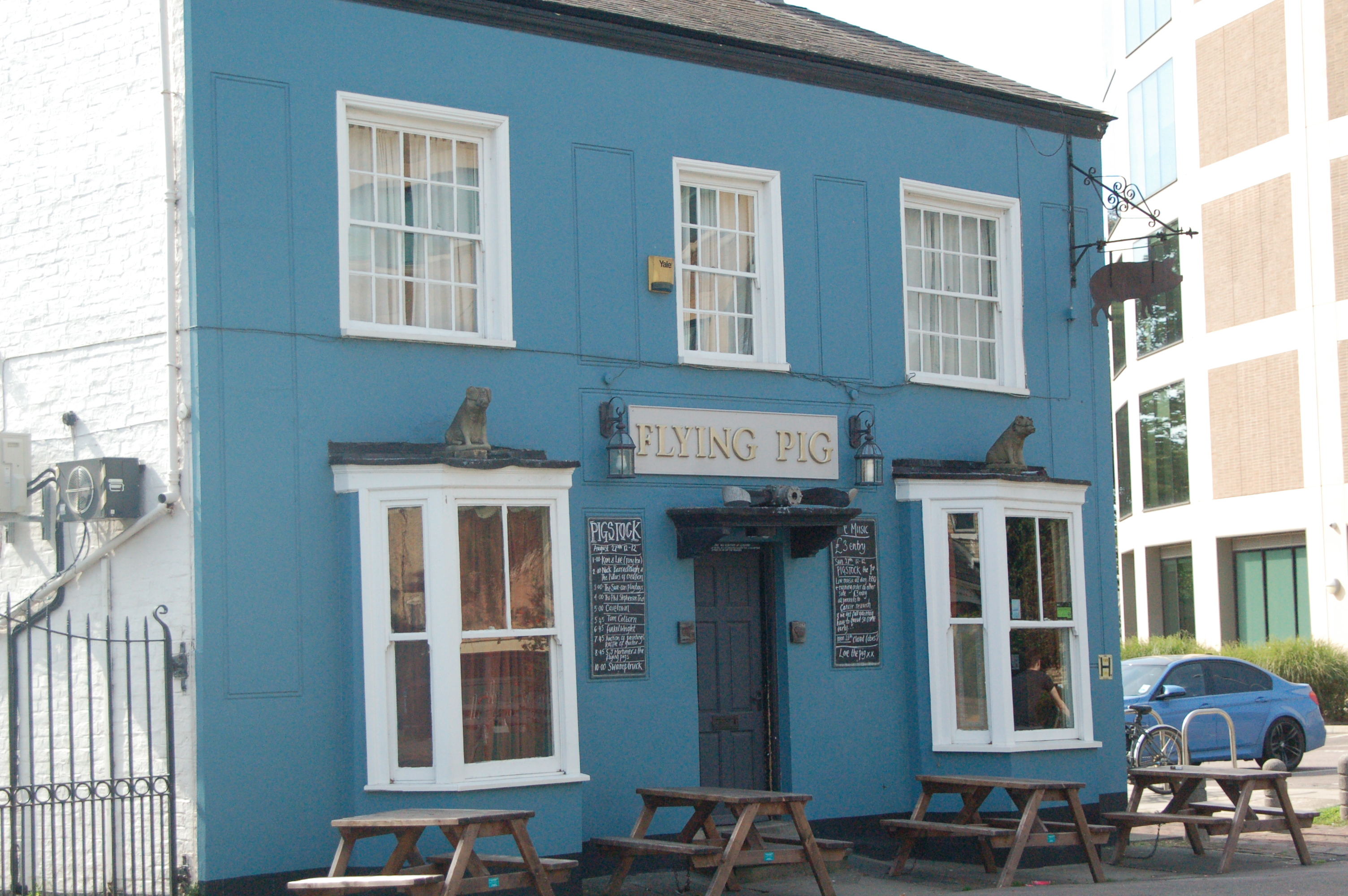
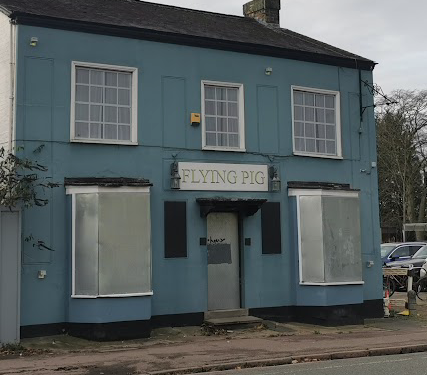
Contribute
Do you have any information about the people or places in this article? If so, then please let us know using the Contact page or by emailing capturingcambridge@
License
This work is licensed under CC BY-NC-SA 4.0





